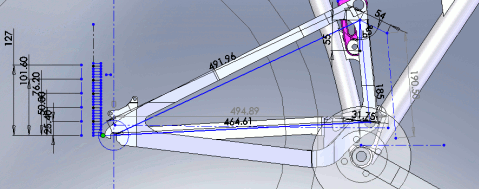Learning things one of the reasons I love figuring out how to do stuff like design a bicycle suspension system. I like knowing how things work–or, more precisely, it bothers me when I don’t know how things work. I’m also one of those people who learns by doing, and by having a project. I learned whatever basic programming languages and design ideas I could from needing to build a web site to sell stuff and not having enough money to pay somebody else to do it for me. Nothing motivates like a project, needing to get something done in order to make some money.
Nevertheless, there’s a lot to be said for having lots of money first. I’d often suspected the correct method for launching a new company looked like this:
- Raise at least a million bucks
- Get some friends together
- Try to think of something to build with the money
Now Vimeo founder and dysfunctional nerd pseudolebrity Jake Lodwick is attempting to prove me right.

Yes, Lodwick has apparently raised $1.5-million for an idea he’s yet to have. Or maybe raising the money will turn out to have been the idea itself–in a kind of meta-statement about the inherent risk of VC funding. All tech startup guys are performance artists at heart, you know. Particularly the ones who can’t code for shit.
At any rate, congratulations to Mr. Lodwick for breaking new ground in combining dubious fame with virtual productivity and value. Even the most grievous example of self-promoting human furniture hasn’t yet figured how to literally get something for nothing.
Given all the white noise around guys like this, it can be difficult to determine just how much genuine intellectual property is being created in the U.S. today, but by almost any measurement, we still think up a lot of stuff.

Still, we seem to have a lot of disco-entrepreneurs like Mr. Hoodwinked Lodwick, versus some increasingly impressive young kids in other countries who are doing some pretty amazing stuff. Consider Nick D’Aloisio, a 16-year-old kid from London whose app, Summly, has some patents pending in the way it uses artificial intelligence, machine learning and ontology to summarize passages of text. One wonders if the D’Aloisio family sedan features a rear window sticker promising “our honor student makes computers smarter than your honor student,” but, according to TheNextWeb, he’s still pretty down to earth and will be staying in school,
currently studying Chemistry, Physics, Biology, Maths, English . . . Latin, Chinese, Russian, philosophy and history
That’s right: “maths.” I don’t think it’s a typo.
It also appears he’s electing to still live with his parents as opposed to buying those stupid sunglasses and moving to Silicon Valley. It sounds twisted to even suggest, but it’s almost as if he didn’t get into the startup game for the money and fame. It’s almost as if he just likes learning and making things.
At any rate, this weekend I learned a few things myself. First, the “gingerbread” Christmas tree decoration that my son brought home from school was not, in fact, edible, even though it smelled like cinnamon (I’ve had worse food at McDonald’s). Second, I learned how to create both rising and falling shock rates in suspension systems, and how to tell at a glance whether your bike’s suspension gets softer or firmer through the mid-range as it compresses.
Falling Rate/Counterclockwise Rocker

Salsa’s new Horsethief starts off firmer, then softens up through the midrange, then firms up again toward the end of its travel. All that information is contained in the upper link seen in the photo. Seen from the drive side like this, the upper link on the Horsethief rotates counter-clockwise, tracing a rough “U” in the air. There have been plenty of bikes that used a similar suspension system, but the Horsethief and Spearfish are really helpful to study, because it’s clear just from looking at them what that upper link does. Normally impacts on the rear wheel would be driving the seat stays almost directly toward the shock, but the little link there is clearly keeping that from happening. Instead of compressing directly, the force driving into the shock is sent on a small detour, looping down before starting to straighten out in line with the shock again. That detour slows the compression of the shock and increases the leverage ratio, making the bike’s suspension softer through that mid-section. Once the link moves far enough to start bringing the force back in line with the shock, the leverage decreases and the suspension gets firmer again.

Same thing with the Santa Cruz VPP system’s upper link, which lets the leverage on the shock increase slightly once the bike is into its travel. Keep in mind you can’t generalize much past the “softer in the middle” part, because the rate of rotation on the two rockers of the VPP system creates a unique scenario, but any arc that translates the rear axle’s movement into a counter-clockwise rotation should yield a suspension system that softens somewhere in the middle.
Rising Rate/Clockwise Rotation

Now consider the DW-link on a Pivot Mach 5.7. Don’t pay any attention to the location of the shock, but check out the orientation of the linkage here: it rotates clockwise, the opposite of the Salsa. That difference generates a rising rate suspension system, or one that firms up as the bike compresses. It’s the rotation of the rocker that dictates the mid-stroke shock rate.
Which way is better? Both. It’s not that simple by any means, and there are good arguments to be made about each method. If you want to know more about what shock rate means and how it works, you should check out Santa Cruz engineer Joe Graney’s excellent article about it, but all you really need to know is that higher numbers are firmer and lower numbers are softer. There could be some exceptions to these rules, but they’d have to have some pretty funky other stuff going on, like really complicated linkages.
What do Summly and shock rates have in common? Discovery. For me, there’s nothing quite like the feeling of discovering something–particularly when it’s a scientific principle you aren’t properly educated to have realized existed in the first place. It’s sort of amazing to discover stuff in the process of trying to create something, and I think everybody should constantly push toward discovering something new that’s maybe just a little intimidating. Instead of just buying a new part to replace something that’s broken, try taking the old one apart first and looking around in there. Instead of searching for a new app, search for instructions about how to make your own. I’m a firm believer that artists should program computers and engineers should start businesses. About the only positive thing I’m sure I’m teaching my kids is that great ideas are earned by constantly trying new things.
Except gingerbread Christmas tree ornaments.


























